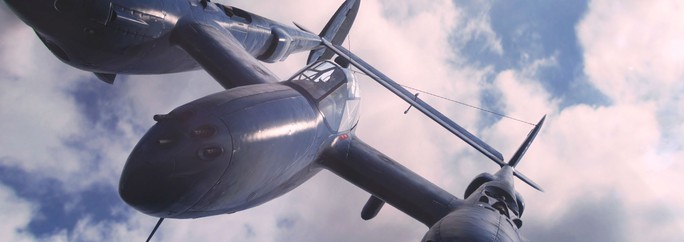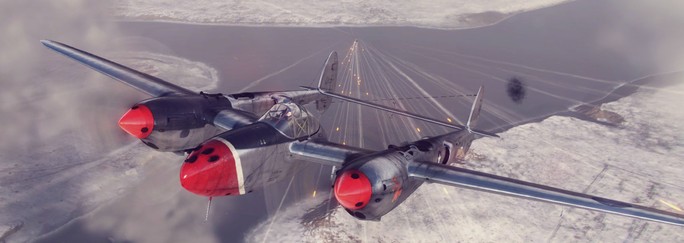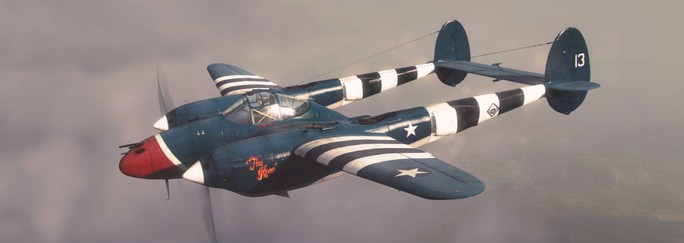-
![LANG-CODE-KEY]() LANG_NAME_KEY
LANG_NAME_KEY

When Version 1.3 hit last month, there was a lot of anticipation among World of Warplanes pilots about the first batch of Heavy Fighters in the U.S. tech tree. The game developers chose the legendary Lockheed P-38F Lightning with its distinctive twin-boom design to be the entry-level plane for this newest class extension.
With over 10,000 aircraft of this type produced throughout WWII, expectations were high for the Lightning to become popular in the game as well. Find out how the "fork-tailed devil" measures up against its competition in our in-depth analysis below!

You can find the P-38F at Tier V of the U.S. Heavy Fighter tech tree. The only way to get to it is through the Curtiss P-40 Warhawk - a solid fighter whose in-flight characteristics prepare you nicely for a smooth transition into the heavier class. The Lightning will cost you 17,500 XP and a whopping 378,000 credits. However, considering the plane and corresponding level of gameplay that you're getting, that's a bargain!

After the consolidation of Light Fighters and Carrier-based Fighters into a single class during the Open Beta, the U.S. tech tree was aching for a bit of diversity on the gameplay front. Although different in range, most of the American fighters required a similar play style that didn't differ much from aircraft to aircraft. The Lockheed P-38F Lightning solves this shortcoming by demanding a very distinct tactical approach, which is not only new to the U.S. tech tree but unique to Heavy Fighters across all nations in general.
Outside of its interesting look, the plane's strongest attribute is an extremely high optimum altitude of 2,100m. The Lockheed warbird can easily cruise at heights of up 3.5km or higher, outclassing its same-tier competitors by at least 400m. Along with this high-flying ability, it features the second-highest airspeed value (587 points or 643km/h top speed) and highest maximum dive speed (850km/h) of the entire tier. Lastly, at up to 222 points, the Lightning is one of the most manoeuvrable planes of its class, completing a full 360° turn as quickly as 28.9s.
On the flipside, the plane comes in last among its peers in both durability (only 280 HP) and firepower (148 points) - a sad fact that is only accentuated by the absence of a rear-gunner. It should also be noted that while the plane excels once it's at high altitude, it isn't the strongest at actually getting there. Its rate of climb begins at an underwhelming 15.5m/s and remains noticeably behind its competition even when fully upgraded to the strongest engine.
 |
 |
 |
 |
Despite this feature, the key to success with this plane is altitude! Customise the Lightning in your hangar so it can reach a comfortable elevation of 2.5km as quickly as possible at the beginning of the battle. Don't make the mistake of being lured down by passing fighters. Simply stay in your aerial comfort zone and first deal with anything that has the capacity to reach your height. Focus on enemy heavy fighters and use your manoeuvrability advantage, always coming down on your enemies from above. Avoid finding yourself below an opponent at all costs (or at least be prepared for a quick getaway to survive).
Once you've cleared out any high-risers and the enemy fighters are busy with each other below you, use the P-38F as a semi-vertical Boom-and-Zoomer. We say 'semi-vertical' because diving too steeply with the Lightning will end up in a crash most of the time due to the aircrafts incredibly fast, hard-to-control diving speed. Boom down on your opponents in a shallow dive, while simultaneously preserving your energy as best you can and being prepared to pull up early enough, even if you didn't manage to shoot down your target. When zooming away, keep the angle equally low in order to maximise your superior speed, which will drop off if you go beyond a 45° elevation.
Don't use the P-38F in turning engagements! Once past an opponent, switch into 'defence mode' immediately by boosting away without needing to change direction. Avoid head-on encounters, even against seemingly light-armed planes, until you've upgraded to the 37mm cannon.
Also be mindful of your weak hull (300 HP max.) and instead use caution and patience to prevail, especially in the earlier battles before you've maxed out your aircraft. Once you've unlocked and mounted all parts, you can become more daring and make full use of the plane's new-found offensive potency and unparalleled high-altitude proficiency.
Wingman Tip: We recommend the use of Armour-Piercing Incendiary Ammunition with all possible P-38F configurations. You will want to balance out your low firepower (for a heavy fighter) as best you can, by squeezing every last bit of damage out of your guns as soon as possible. Adding the 'Improved Reflector Sight' will work wonders for your hit ratio and help you set your opponents on fire – which is a must in a plane that can use help finishing off opponents if the first (or second) fly-by doesn’t manage to take out a target.

The Lightning is a truly two-faced plane that has a tough time while on its stock configuration, but picks up in all aspects to become a veritable beast when maxed out. The trick is to work around the plane's limitations while grinding to the stronger modules. Those who keep their patience early on will be rewarded with an enormous proficiency boost that will make the plane seem like it jumped a tier up!

| Name | Weight (in kg) | HP |
|---|---|---|
| P-38F | 5293 | 280 |
| P-38G | 5300 | 300 |
Since your plane is really lacking in durability, rate of climb and firepower at the beginning, and all are equally important to a heavy fighter, there isn’t really one particular module that you need to start upgrading first. If you choose to begin with the airframe, you’ll be rewarded with a small but helpful 20 HP-boost, an even higher diving speed and a 0.7s shorter average time to turn. Since this doesn’t have any downsides, buying this airframe is pretty much a no-brainer.

“Catch me if you can!” – said the P-38F to the tailing fighter as it disappeared into the clouds.

| Name | Weight (in kg) | Type | Power (in h.p.) |
|---|---|---|---|
| 2xV-1710-27 | 1200 | water-cooled | 1150 |
| 2xV-1710-49 | 1220 | water-cooled | 1325 |
| 2xV-1710-91 | 1240 | water-cooled | 1425 |
Upgrading your initial V-1710-27 engines is a must on the P-38F in order to be able to employ typical Heavy Fighter tactics. The first upgrade to the V-1710-49 will not only grant you a much needed additional 1.8m/s to your rate of climb, but also boost your speed characteristics, which is another unique selling point of your aircraft. You will add an extra 0.8s to your average time to turn but if you’ve already upgraded your airframe to the sleeker, more aerodynamic model, then you won’t feel the difference.
In order to unlock the full potential of the Lightning, you’ll have to spend another 11,200 XP and 60,000 credits to install the V-1710-91 engine. This Tier VII model will further increase your rate of climb to a decent 19.1m/s and, most importantly, add another 17km/h to your top speed at best altitude. You will never be slow in the P-38F but to truly excel at evading your foes as you employ its high-altitude tactics, you’ll need this bit of extra performance.

| Name | Weight (in kg) | Rate of Fire (in r/min) | Damage (per second) |
|---|---|---|---|
| 23 mm Madsen (C) | 123 | 350 | 92 |
| 20 mm M2 (C) | 129 | 700 | 102 |
| 37 mm M4 (C) | 146 | 150 | 200 |
This plane clearly lacks punch for a heavy fighter, which makes upgrading its guns an absolute must so that it can be competitive against its same-tier rivals. Luckily, the cost for module upgrades (stats-wise) is very low on the P-38F, so you needn’t worry about what you’re sacrificing as you improve your aircraft.
The first available M2 (C) cannon adds a modest but nonetheless much-needed 20 points of firepower while costing you nothing in terms of manoeuvrability. Although it may seem like a downgrade at first to exchange a 23mm gun for a 20mm-calibre model, the Tier VI cannon actually doubles your rate of fire and extends your range by 150m. If you’re coming from playing German Heavy Fighters, which are very precise long-range snipers, and you are looking to stick with this play style then you’ll want to choose this setup. You’ll definitely feel the impact of the stronger gun but if you want to experience the unique gameplay that the Lightning can deliver then you’ll need to start saving for the next upgrade as soon as possible.

The Tier VII 37mm M4 (C) cannon will cost you the noble sum of 20,500 XP and 47,500 credits, almost as much as progressing to the next aircraft in the tech tree, but it will prove worth the investment in the long run. This beast of a gun will double the damage output of your cowling-mounted weapon, dishing out a whopping 200 damage per second and raising your firepower score to a respectable 221 points.
However, much like other high-calibre cannons such as the Bf 110 C-6’s fearsome 30mm MK-101 (D), its punch only really kicks in at short distances. You’ll have to change up your tactics and adjust accordingly to get closer to your foes before you can open fire. Be prepared to strike at distances of 400m or less, without engaging in turn-and-burn dogfights!
On the plus side, with the 37mm cannon equipped, it’s unlikely that you’ll need more than one pass to finish off opponents (especially lighter ones). However, if you do, the trick is to stick to a ‘defence first’ mindset and not get too cocky, even if it looks like you have the superior firepower on paper.

| Name | Weight (in kg) | Damage | Damage Radius (in m) |
|---|---|---|---|
| 500 pound bomb | 225 | 6000 | 100 |
| 4.5’’ M8 rocket | 17 | 750 | 40 |
Since the Lightning was mostly used as a bomber during its real-life service, the developers included the option for the plane to carry two 500 pound-bombs in the game as well. However, given the way the Lightning needs to be played in order to be successful (high in the clouds with only minimal stints close to the ground when ‘booming’ down on opponents), you won’t have much opportunity to actually get rid of your payload. Since the bombs also severely cut into your rate of climb (-2.3m/s) and because altitude is your saviour on the P-38F, adding the extra weight seems unnecessary and counterintuitive. We therefore don’t recommend it.
It’s pretty much the same deal with the rockets. Although they’re a bit lighter, they’ll still drag you down. Worst of all, even if you don’t feel the extra weight too much, the rockets will significantly impact your play style, making you drop to lower altitudes to hit ground targets. It is during these moments, going in a straight line below 1,000m, that you would expose yourself badly. On a plane like the Lightning, this will end in your destruction 99% of the time.
If you insist on carrying the rockets, concentrate on small ground targets such as AA-guns. They’re usually around 750HP, which is small enough to be taken out with a single rocket, so you can then quickly zoom away into the sky.

Here’s our recommendation for equipment to further boost the plane’s performance:
| 1st |  |
Improved Reflector Sight The 37mm cannon is pretty inaccurate and has a low rate of fire. Get the 10% accuracy booster to make every shot count! |
|---|---|---|
| 2nd |  |
Reinforced Covering II With a heavy fighter as fragile as the P-38F, you’ll want to pack a little extra insurance to give you extra durability. |
| 3rd | .jpg) |
Aircraft Polish I Opt for the +5% top speed booster to give you that edge when you try to break away from your enemies. |
Make sure you bring the following consumables for your sorties:
|
|
120-octane Gasoline You’ll spend a lot of your time gaining altitude in the P-38F. The extra 5% engine boost is priceless in that regard. |
|
|
Pneumatic Restarter Pack a Pneumatic Restarter in case you happen to experience an engine failure when low to the ground. Better safe than sorry! |
Now it's up to you to become a 'King above the Clouds', pilots!